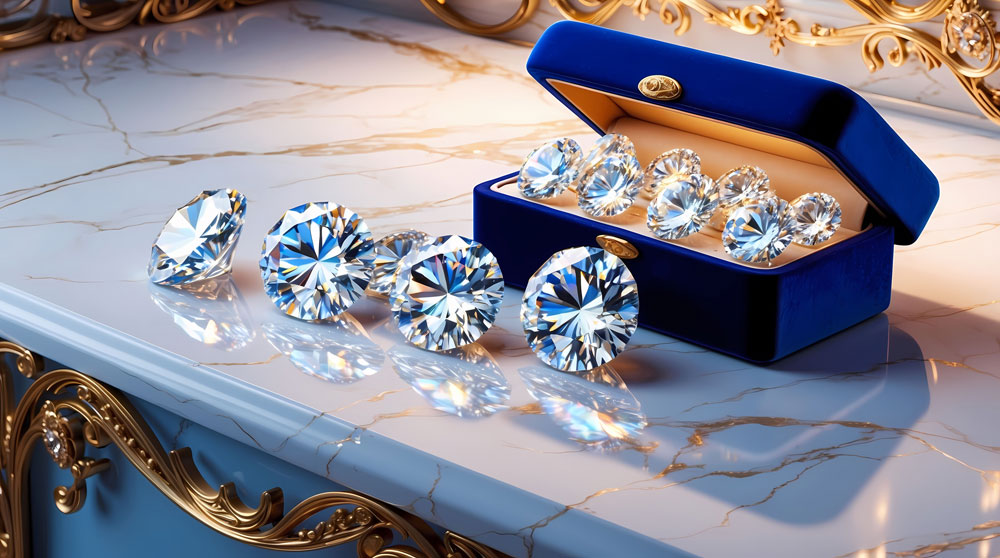Once the Second Most Popular Diamond Shape, Princess Cut Diamonds are Now a Needle in the HaystackMost Popular Diamond Shape

The decline in popularity of princess cut diamonds is a noticeable trend in the jewellery industry, driven by changing consumer preferences, shifts in fashion trends, and evolving cultural attitudes toward diamonds. Once one of the most sought-after diamond shapes, the princess cut is now being overshadowed by other diamond styles and cuts. This shift can be attributed to a variety of factors, including changes in aesthetic preferences, advances in diamond cutting technology, and a desire for uniqueness among consumers.
Introduced in the 1980s, the princess cut quickly gained popularity due to its modern appeal and affordability. The square shape with sharp corners offered a contemporary alternative to the traditional round brilliant cut, which dominated the market. Its popularity surged in the early 2000s, partly because of its versatility and the brilliance it offered at a lower cost compared to round diamonds. Princess cuts, with their sharp lines and geometric design, fit perfectly into the modernist and minimalist trends of the time. Many couples seeking engagement rings were drawn to the sleek and sophisticated look of the princess cut.
However, in recent years, the allure of princess cut diamonds has waned. One major factor in this decline is the shifting aesthetic trends in the jewellery market. Modern consumers, particularly Millennials and Gen Z, are gravitating toward softer, more organic shapes. Oval, pear, and cushion cuts have gained traction, reflecting a preference for a more vintage-inspired and delicate aesthetic. The sharp corners of princess cut diamonds, once seen as edgy and contemporary, are now often perceived as too harsh or dated in comparison to these more fluid shapes.

The humble princess cut is now virtually nowhere to be seen.
Moreover, there is a growing preference for unique, unconventional diamond shapes, such as marquise, Asscher, and emerald cuts, which offer a distinct look compared to the classic and somewhat ubiquitous princess cut. This shift indicates a change in the cultural landscape, where consumers are increasingly seeking jewellery pieces that reflect their individuality and personality. In this context, the princess cut, which was once popular for its blend of tradition and modernity, now finds itself overshadowed by more unique shapes that allow for greater self-expression.

Asscher and emerald cuts are now very popular.
Advances in diamond cutting technology have also influenced the decline in the popularity of princess cuts. Over the past decade, the ability to cut diamonds into intricate and unusual shapes has expanded, allowing for more variety and creativity. While the princess cut was once prized for its brilliance, new advancements in diamond cuts, such as the radiant or cushion cuts, offer similar brilliance while having more versatility in setting styles and overall design. Consumers today have a wider range of options, and many are opting for cuts that can be more easily customised or tailored to their tastes.

The use of lasers in diamond cutting has greatly reduced costs and allowed for unlimited creativity when cutting.
The cultural narrative around diamonds and engagement rings has also shifted, impacting the popularity of traditional diamond shapes like the princess cut. As younger generations question the conventional norms around marriage, engagement rings are no longer seen solely as traditional symbols of commitment. Many couples are opting for non-traditional engagement rings, such as rings featuring coloured gemstones, unique cuts, or alternative materials. This change has contributed to the decline of the princess cut, which was once a staple in traditional engagement rings.
Furthermore, the princess cut is known for having more fragile corners compared to round or cushion cuts, making it more prone to chipping. Consumers are becoming more knowledgeable about diamond durability and are increasingly prioritising practicality and longevity in their jewellery choices. Shapes with rounded corners, such as oval or cushion cuts, are often viewed as more durable options, making them more appealing to buyers who want their rings to withstand daily wear.
Another factor contributing to the decline is the increasing desire for ethical and sustainable diamonds. As consumers become more aware of the environmental and social impact of diamond mining, many are choosing lab-grown diamonds or alternative gemstones. These newer options often allow for greater creativity in design and cut, enabling consumers to move away from traditional diamond shapes like the princess cut. The rising popularity of lab-grown diamonds, which can be more easily cut into unconventional shapes, has further fuelled this trend.
The decline in princess cut diamonds is also a reflection of broader changes in consumer behaviour. Social media has significantly shaped preferences, as influencers and celebrities often set trends by showcasing unique or vintage-inspired engagement rings. With the rise of Instagram and Pinterest, brides-to-be are exposed to many ring designs and are drawn to cuts that offer more visual interest or customization options. The popularity of antique-inspired rings, which typically feature round, oval, or cushion-cut stones, has further shifted the focus away from the princess cut.
In conclusion, the decline in the popularity of princess cut diamonds can be attributed to several interconnected factors. Shifting aesthetic preferences, advances in cutting technology, evolving cultural norms, and the desire for uniqueness all play a role in the decreasing demand for this once-favoured diamond shape. While the princess cut remains a classic choice for some, it is clear that modern consumers are seeking options that align with their individuality, values, and the current trends in jewellery design. As the market continues to evolve, it will be interesting to see how the princess cut adapts to these changes or if it experiences a resurgence in popularity in the future.



